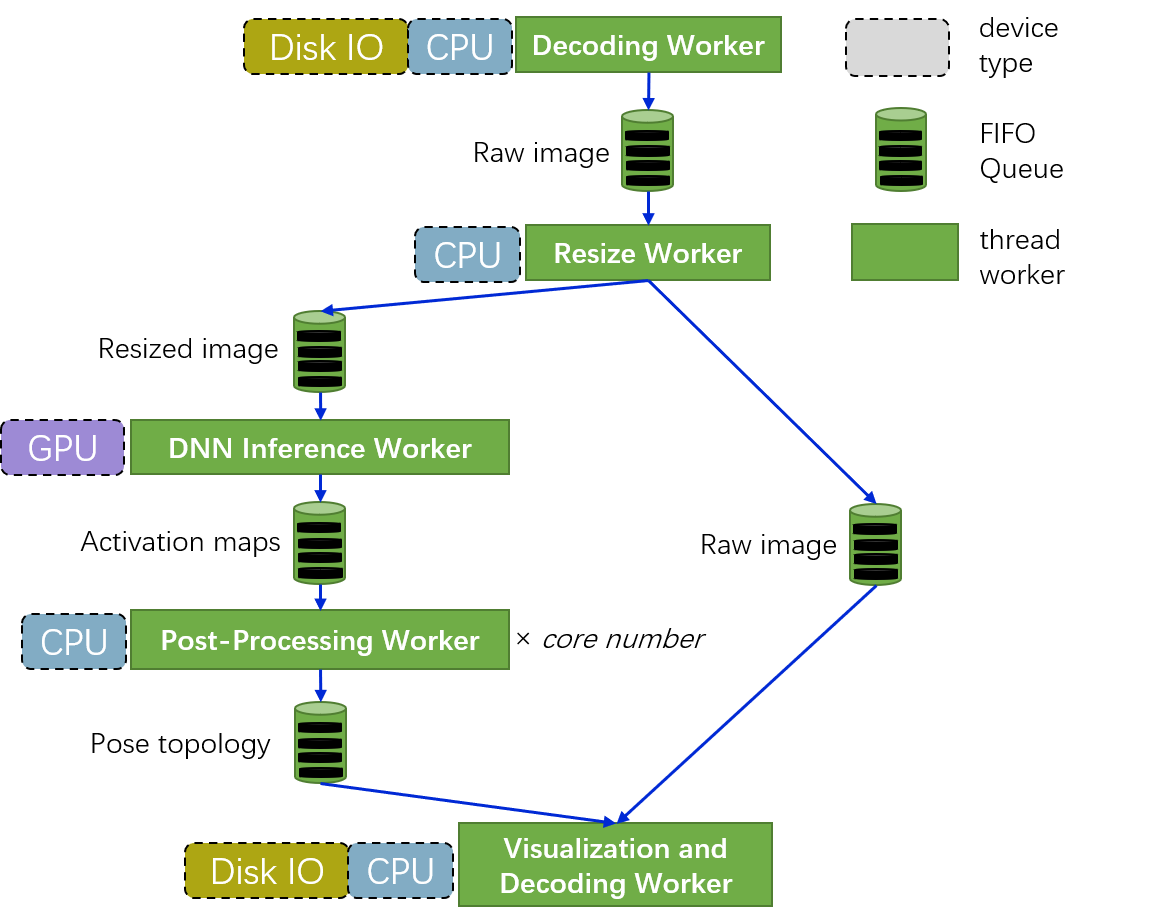Overview¶
Why HyperPose¶
HyperPose provides:
Flexible training
Well abstracted APIs (Python) to help you manage the pose estimation pipeline quickly and directly
Dataset (COCO, MPII)
Pose Estimation Methods
Backbones: ResNet, VGG (Tiny/Normal/Thin), Pose Proposal Network, OpenPifPaf.
Post-Processing: Part Association Field (PAF), Pose Proposal Networks, PifPaf.
Fast Prediction
Rich operator APIs for you to do fast DNN inference and post-processing.
2 API styles:
Operator API (Imperative): HyperPose provides basic operators to do DNN inference and post processing.
Stream API (Declarative): HyperPose provides a streaming processing runtime scheduler where users only need to specify the engine, post-processing methods and input/output streams.
Model format supports:
Uff.
ONNX.
Cuda Engine Protobuf.
Good performance. (see here)
Prediction Library Design¶
HyperPose Prediction Pipeline¶
HyperPose supports prediction pipelines described in the image blow. (Mainly for bottom-up approaches)

Operator API & Stream API¶
Operator API provides basic operators for users to manipulate the pipeline. And Stream API is based on Operator API and makes higher level scheduling on it.
Minimum Example For Operator API¶
To apply pose estimation to a video using Operator API:
#include <hyperpose/hyperpose.hpp>
int main() {
using namespace hyperpose;
const cv::Size network_resolution{384, 256};
const dnn::uff uff_model{ "../data/models/TinyVGG-V1-HW=256x384.uff", "image", {"outputs/conf", "outputs/paf"} };
// * Input video.
auto capture = cv::VideoCapture("../data/media/video.avi");
// * Output video.
auto writer = cv::VideoWriter(
"output.avi", capture.get(cv::CAP_PROP_FOURCC), capture.get(cv::CAP_PROP_FPS), network_resolution);
// * Create TensorRT engine.
dnn::tensorrt engine(uff_model, network_resolution);
// * post-processing: Using paf.
parser::paf parser{};
while (capture.isOpened()) {
std::vector<cv::Mat> batch;
for (int i = 0; i < engine.max_batch_size(); ++i) {
cv::Mat mat;
capture >> mat;
if (mat.empty())
break;
batch.push_back(mat);
}
if (batch.empty())
break;
// * TensorRT Inference.
auto feature_map_packets = engine.inference(batch);
// * Paf.
std::vector<std::vector<human_t>> pose_vectors;
pose_vectors.reserve(feature_map_packets.size());
for (auto&& packet : feature_map_packets)
pose_vectors.push_back(parser.process(packet[0], packet[1]));
// * Visualization
for (size_t i = 0; i < batch.size(); ++i) {
cv::resize(batch[i], batch[i], network_resolution);
for (auto&& pose : pose_vectors[i])
draw_human(batch[i], pose);
writer << batch[i];
}
}
}
Minimum Example For Stream API¶
To apply pose estimation to a video using Stream API:
#include <hyperpose/hyperpose.hpp>
int main() {
using namespace hyperpose;
const cv::Size network_resolution{384, 256};
const dnn::uff uff_model{ "../data/models/TinyVGG-V1-HW=256x384.uff", "image", {"outputs/conf", "outputs/paf"} };
// * Input video.
auto capture = cv::VideoCapture("../data/media/video.avi");
// * Output video.
auto writer = cv::VideoWriter(
"output.avi", capture.get(cv::CAP_PROP_FOURCC), capture.get(cv::CAP_PROP_FPS), network_resolution);
// * Create TensorRT engine.
dnn::tensorrt engine(uff_model, network_resolution);
// * post-processing: Using paf.
parser::paf parser{};
// * Create stream
auto stream = make_stream(engine, parser);
// * Connect input stream.
stream.async() << capture;
// * Connect ouput stream and wait.
stream.sync() >> writer;
}
Using the Stream API, it is much faster and with less codes!
Stream Processing in Stream API¶
Every worker is a thread.
Every worker communicates via a FIFO queue.
The DNN inference worker will do greedy batching for the inputs.
